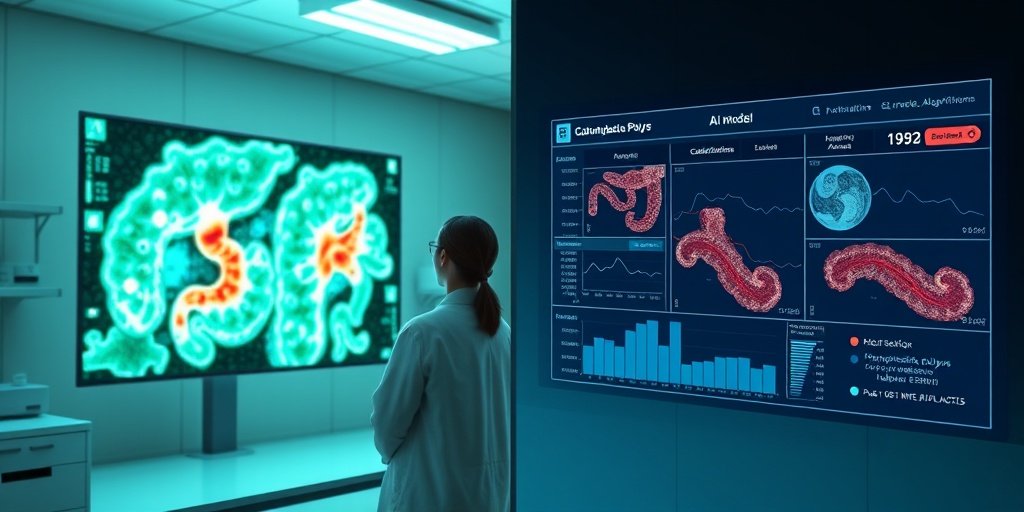⚡ Quick Summary
This study explores the use of AutoML algorithms to develop an AI model for the classification of colon polyps, achieving an impressive 100% accuracy for identifying tubular adenomas and hyperplastic polyps. The findings suggest that such models can significantly enhance the efficiency of digital pathology practices.
🔍 Key Details
- 📊 Dataset: Whole-slide images from public and institutional databases
- 🧩 Classifications: Hyperplastic polyps, tubular adenomas, and normal colon
- ⚙️ Technology: AutoML algorithms from Google’s VertexAI platform
- 🏆 Performance: 100% accuracy for tubular adenomas and hyperplastic polyps, 97% for normal colon
🔑 Key Takeaways
- 🤖 AI models can improve diagnostic efficiency in pathology.
- 💡 AutoML algorithms are accessible and effective for developing diagnostic tools.
- 📈 High accuracy rates were achieved in classifying colon polyps.
- 🌐 Cloud-based platforms like Google’s VertexAI facilitate the development of AI models.
- 🔍 Study highlights the potential of AI in enhancing diagnostic processes.
- 🏥 Implications for pathologists in improving patient care through technology.

📚 Background
The field of digital pathology is rapidly evolving, with artificial intelligence (AI) playing a pivotal role in enhancing diagnostic accuracy and efficiency. As AI models become more accessible, there is a growing interest in their application within pathology, particularly in the classification of various tissue samples. This study aims to investigate the effectiveness of AutoML algorithms in developing robust AI models for colon polyp classification.
🗒️ Study
Conducted by researchers from various institutions, this study utilized whole-slide images from both public and institutional databases to create a training set for classifying colon polyps into three categories: hyperplastic polyps, tubular adenomas, and normal colon. The AI model was developed using an AutoML algorithm from Google’s VertexAI platform, with a test subset reserved to evaluate the model’s accuracy, sensitivity, and specificity.
📈 Results
The AI model demonstrated remarkable performance, achieving a 100% accuracy in identifying both tubular adenomas and hyperplastic polyps, while also attaining a 97% accuracy for normal colon classification. The sensitivity and specificity error rates were notably low, indicating the model’s reliability in diagnostic applications.
🌍 Impact and Implications
The implications of this study are significant for the field of digital pathology. By leveraging accessible AutoML algorithms, pathologists can enhance their diagnostic capabilities, leading to improved patient outcomes. The successful application of AI in classifying colon polyps could pave the way for broader adoption of similar technologies in other areas of pathology, ultimately transforming how diagnoses are made.
🔮 Conclusion
This study highlights the transformative potential of machine learning in the realm of digital pathology. The development of an AI model using AutoML algorithms not only demonstrates high accuracy in colon polyp classification but also underscores the importance of integrating technology into healthcare practices. As we move forward, continued research and development in this area will be crucial for advancing diagnostic efficiency and improving patient care.
💬 Your comments
What are your thoughts on the integration of AI in pathology? Do you believe it can significantly change diagnostic practices? 💬 Share your insights in the comments below or connect with us on social media:
Automating Colon Polyp Classification in Digital Pathology by Evaluation of a “Machine Learning as a Service” AI Model: Algorithm Development and Validation Study.
Abstract
BACKGROUND: Artificial intelligence (AI) models are increasingly being developed to improve the efficiency of pathological diagnoses. Rapid technological advancements are leading to more widespread availability of AI models that can be used by domain-specific experts (ie, pathologists and medical imaging professionals). This study presents an innovative AI model for the classification of colon polyps, developed using AutoML algorithms that are readily available from cloud-based machine learning platforms. Our aim was to explore if such AutoML algorithms could generate robust machine learning models that are directly applicable to the field of digital pathology.
OBJECTIVE: The objective of this study was to evaluate the effectiveness of AutoML algorithms in generating robust machine learning models for the classification of colon polyps and to assess their potential applicability in digital pathology.
METHODS: Whole-slide images from both public and institutional databases were used to develop a training set for 3 classifications of common entities found in colon polyps: hyperplastic polyps, tubular adenomas, and normal colon. The AI model was developed using an AutoML algorithm from Google’s VertexAI platform. A test subset of the data was withheld to assess model accuracy, sensitivity, and specificity.
RESULTS: The AI model displayed a high accuracy rate, identifying tubular adenoma and hyperplastic polyps with 100% success and normal colon with 97% success. Sensitivity and specificity error rates were very low.
CONCLUSIONS: This study demonstrates how accessible AutoML algorithms can readily be used in digital pathology to develop diagnostic AI models using whole-slide images. Such models could be used by pathologists to improve diagnostic efficiency.
Author: [‘Beyer D’, ‘Delancey E’, ‘McLeod L’]
Journal: JMIR Form Res
Citation: Beyer D, et al. Automating Colon Polyp Classification in Digital Pathology by Evaluation of a “Machine Learning as a Service” AI Model: Algorithm Development and Validation Study. Automating Colon Polyp Classification in Digital Pathology by Evaluation of a “Machine Learning as a Service” AI Model: Algorithm Development and Validation Study. 2025; 9:e67457. doi: 10.2196/67457